Servicios Personalizados
Revista
Articulo
Indicadores
Links relacionados
Compartir
Revista Boliviana de Química
versión On-line ISSN 0250-5460
Rev. Bol. Quim v.24 n.1 La Paz 2007
ARTÍCULO ORIGINAL
Proximal Composition and Mineral contents of Six Varieties of Cassava (MANNIHOT ESCULENTA, CRANTZ), FROM BOLIVIA
C. Carola Rojas1,3, Baboo Nair2, Adelina Herbas3 and Björn Bergenståhl1
1Food Technology, Lund University, P.O Box 124, SE-221 00 Lund, Sweden, 2Applied Nutrition, Lund University, P.O Box 124, SE-221 00 Lund, Sweden, 3Centro de Alimentos y Productos Naturales, Universidad Mayor de San Simón, Cochabamba, Bolivia
ABSTRACT
Six varieties of Cassava (Yucca) from Chapare (Provincia of Cochabamba-Bolivia) have been studied and a proximal analysis has been carried out.
Words Key: Cassava, analysis, proximal, starch, minerals.
INTRODUCTION
In recent years, the Bolivias government has tried to develop in the tropical region of Cochabamba, Chapare. This region is tropical and is considered a very rich in natural resources; fruits, vegetables and roots. One of the main crops in this area is sweet cassava (Mannihot esculenta Crantz)
The cassavas production has a vital importance from a social and economic perspective according to regional plans of development. It has an importance to the local farmers both as a crop for consumption within the household as well as a crop for trade.
Cassava is a tropical, perennial plant originating from Latin America. Cassava has been domesticated and insert in the New World tropics in the late fifteenth century (18).
Cassava is a root that has many attributes that makes very interesting for the farmers. Cassava is insensitive to drought, it is not demanding in fertilization, it is insensitive to pests, it is not laborious to farm and it gives a high yield. However, it is a crop with a primarily high content of carbohydrates and the protein content is low.
In the tropical regions, cassava is the most important root crop and as a source of energy for human consumption it ranks fourth after rice, sugar cane and maize. It is a major carbohydrate food for an estimated 500 million people and in tropical Africa (19).
Cassava can be divided in two different principal types; sweet and bitter cassava, depending on the cyanide content. Bitter cassava has a bitter taste and high cyanide content. These varieties need to be detoxified before consumption through different types of treatments. In Bolivia the sweet variety with low cyanide content dominates and it can be consumed either fresh (boiled, baked, fried or pounded) or in numerous processed forms (18). Cassava is of growing importance as animal feed and as a raw material for producing starch. Over the last 20 years, there has been mounting recognition of the contributions that cassava can make to increasing incomes and generating employment opportunities in the rural economy (19).
The cassava root is easily deteriorated by atmospheric contact after harvest. One way to overcome these problems is to process the cassava roots into dry form. The main objective of this study is to characterize six common varieties of cassava found in Chapare, with the purpose of choosing the appropriate variety to work with to develop new products from it with more added values in a short term.
RESULTS AND DISCUSSION
Six varieties of cassava from Bolivia (Bobore (a), Noveton (b), Valencia (c), Amarilla (d) Cambayuca (e) and Bobore (f)), were analyzed. The proximate composition (% based on DM) is given in Table 1 and in the Figures 1 and 2.
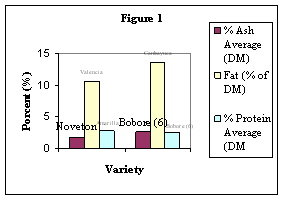
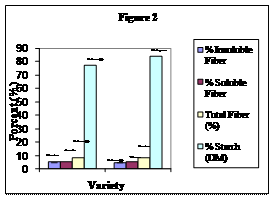
The starch content was ranging from 71.6 % to 84%, with an average of 75%. Valencia showed the lowest value, with 71.6%, and the Cambayuca variety was displayed the highest content of starch with 84%.
The total fiber content ranged from 7.4 % 8.5%, with an average around 8.2%. The lowest value was obtained for the variety Bobore, 7.4%. These values were higher than the reported by Kay (1) (1%) but similar than the values reported by Dominguez (10) and Ravindran (11), with 7.3% and 8.5% respectively. Potato has much less fibres, 1.6% was obtained by Karuna et al (12). The insoluble fiber fraction range between 2.7% and 5.1% with an average of 3.7%. The highest value was 5.1% obtained for the Bobore (a) variety. The soluble fiber fraction range between 3.3% and 5.5%, with an average of 4.5%. The highest reported value was for was for the Valencia variety with 5.5%.
The crude protein content, in the present study, ranged from 1.5% to 2.8% and in average 2%. The Valencia and Cambayuca varieties deviates with low protein content. The results are in agreement with the values reported for cassava by Kay (1). Cassava has a very low protein content, for instance potato contains much more protein, typical around 10% (based on DM) (12).
The lipid content shows values between 0.6% and 1.4% with an average of 1.0%. The Noveton variety, had the lowest quantity 0.6%, and the Cambayuca variety showed the highest value 1.4%, Figure 1. The results agrees well with the previous study by Dominguez (10) and Ravindran et al. (11) who found that the lipid values varied between 0.8% and 1.4%. Lipids reported for other roots, like potato (Karuna D. et al.) (12), is comparable, about 1.0%, to cassava in this study.
The ash content goes from 1.5% until 2.7%, in all varieties studied. Ash of Bobore (IBTA Chimore) variety reached 2.7 %, becoming almost twice in comparison with the other varieties like is showed in the Figure 1. Kay (1) has reported ash content in cassava in a lower range (the range was 0.5-1.5% DM
The mineral content in all the varieties, were analysed and it is summarized in the Table 1.
All the results are compared with the elemental composition of the earth crust by Rimbac (21) in Figure 3. Looking at the data Figure 3, we can divide the mineral content in three groups: one of overrepresented elements in the cassava samples in comparison with the earth crust, this group includes K, P, Zn, Br, Cl, S, B and Rb. The second group that contain well represented elements with similar concentration in the cassava root as in the crust of the earth: Ca, Mg, Ba, Sr, Cu, Au and Ni. The third group is a large number of elements that have an appearance in cassava far below their presence in the earth crust- under represented elements. This group includes elements like Na, Fe, Si, Sn, Mo, Cd and the heavy metals like Pb and Hg.
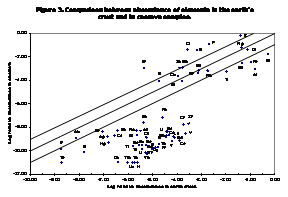
The first group, the enriched elements, it partly represents elements with a clear physiological role in the plant: K, P, Zn, S, and Cl. We may assume that the plant together with these elements absorbs other elements with similarities in the fundamental chemistry (e. g. ion radius, charge, hydroxide formation etc). A few of these coabsorbed elements belongs to group 1 (overrepresented elements), but most to group 2 (Well represented elements). K has an ionic radius of 1.3 Å. We can assume that Rb (ion radius 1.4Å) is accumulated in the same process. Similarly Au ions (ion radius 1.4Å) may be selectively accumulated and thereby occur at a surprisingly high concentration (Group 2). Zinc (2+, 0.7 Å) can be assumed to be selectively absorbed as it has an essential role in a number of enzymes as superoxiddismutas, alcoholdehydrogenas and carboanhydrase in plants (22). Cu, Ni and Mn have similar radius and are also quite abundant in the plant. Mg (2+, radius 0.65 Å) and Ca (2+, radius 0.9) also have important biological roles in the plant and with them follows also a number of similar elements. Sr and Ba can be assumed to follow with the Ca and are also quite abundant.
The third group (under represented elements) contains a list of elements appearing with a much lower frequency in the plant than in the crust. Sodium is actively avoided by the cellular tissue. Maybe Li and Ag is reduced due to its similarity in ion radius to Na (about 1 Å or less). Many of the elements in group three appears in the nature as oxides with very low solubility (Fe, Ni, Co, Si, Ti, Al, Mo, Sn, Cr). Other elements are poorly represented as they appears as highly insoluble sulfides (for instance Bi, Ag, Hg, Sb, Cd, Pb,V,Ge), carbonates (Pb, Ce, La, Th, Y, Nd), phosphates (Ce, Er, Yb, Dy, La, Th, Y, Nd), silicates (Be, Cs, In, Gd, Ho, La, Nd, Zr, Y, Sc, Li, Ha) or as metal salts (for instance W, Te, Se, As). These poorly soluble elements can be expected to occur to a relatively low extent.
EXPERIMENTAL
The varieties investigated were: Bobore (a), Noveton (b), Valencia (c), Amarilla (d) and Cambayuca (e). The samples (escept the Bobore sample) were all obtained from Estación Experimental la Jota, (It is located in the Municipio de Chimoré of Chapare to 190 Km of the Cochabamba city). The Bobore sample (f) were obtained from Chimore Experimental Plantations of IBTA-Chapare (Geographical location!).
Equipments
- Miller (Cyclotec 1093, Tecator AB, Höganäs, Sweden)
- Kjeldahl semi micro automatic analys system, Kjeltec Auto System (Tecator AB, Höganäs, Sweden)
- Fiber analyzer Fibertec 1020 (M6) (Tecator AB, Höganäs, Sweden)
- UV Spectrophotometer (Lambda 2 series 3742, Perkin Elmer)
- Inductively coupled plasma- atomic emission spectrometry, ICP AES Optima 3000 DV (Perkin Elmer)
Inductively coupled plasma- Mass spectrometry,ICP MS Elan 6000 (Perkin Elmer)
Row Material.
Initially, the cassava roots were peeled and the roots were cut with knife into small pieces. The pieces were dried using a freeze drying equipment. The operation conditions were: -47 °C and final pressure was 0.3 mbar. The dried material was ground into flour by using a standard mill
(Cyclotec 1093, Tecator, Sweden). The particle size was 40-60 mesh. Then, the flour samples were stored in a cool room, the temperature was T° = 8 °C.
Proximal Composition
Moisture, ash and crude fat of the samples were assayed according to the methodology of the American Association of Cereal Chemists (AACC, method 44-15A (8)). Protein in flour was determined using Kjeldahl method using the Kjeltec Auto System.
Determination of dietary fiber.
Soluble and insoluble dietary fiber content was determined enzymaticaly method as described by Asp (19). The dietary fiber values were corrected for protein and ash.
Determination of total Starch with KOH.
Starch determination was by method of Holm (3). It was achieved an incubation with Termamyl (Novo A/S, Copenhagen, Denmark) and amyloglucosidase (Boehringer Nr 1202367 3500U/25 ml).
2.6. Mineral Content.
Mineral content of six varieties of cassava were analyzed by Ecology Department in Lund University.
The technique, which was used, is the following:
0.2 g of sample was weighed; after, 5 ml concentrated acid and 5 ml water was added to the sample. Then, the sample was run in a microwave oven for two hours. After digestion, each sample was diluted to 50 ml with deionized water. Some of the elements (Ca, Fe, K, Mg, Na, P, and S) were analyzed with ICP AES, the rest with ICP MS.

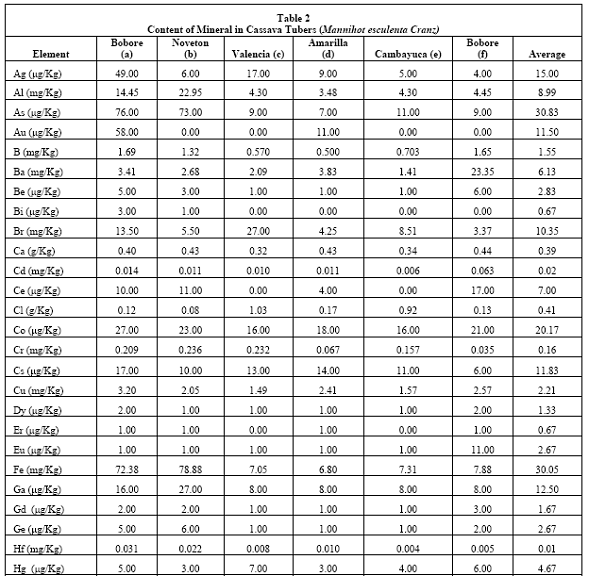
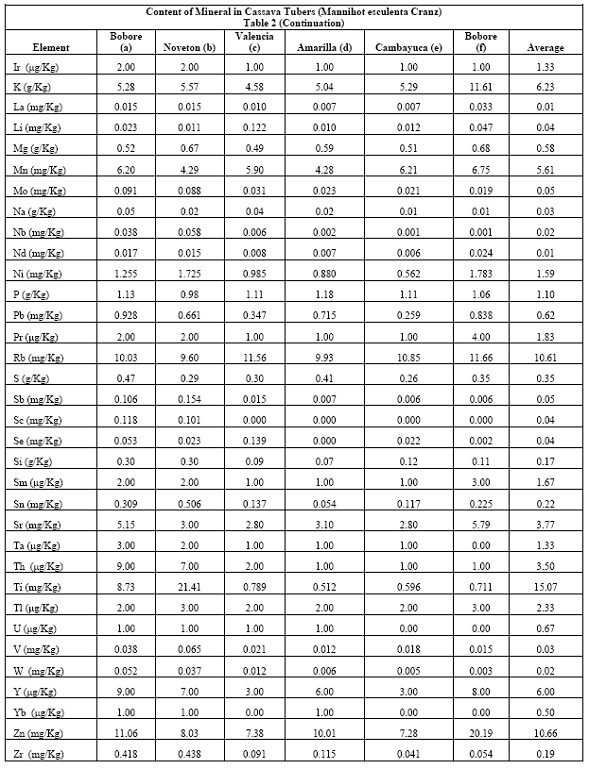
CONCLUSION.
From the six varieties studied it is possible to conclude that:
The starch content of the 6 varieties was in the same range, between 71.6% to 84% with an average of 75% . The total fiber content varied between 7.4% and 8.5%, with an average of 8.2%. The values of total lipids varied between 0.6% and 1.4%.
In the ash varied between 1.5% and 2.7%. The elemental composition can be compared with the composition of the crust of the earth. Certain elements are important and occur at high ratio, other
elements resemble of the important ones and thereby
also are enriched in the tissues. A majority of the elements occurs less commonly in the tissue of the plant as they not are enriched or as they are poorly soluble.
ACKNOWLEDGEMENTS.
The study was supported by Swedish International Development Agency (SIDA/SAREC) in the project between Universidad Mayor de San Simon (Bolivia), and Lund University (Sweden).
REFERENCES
1. KAY, CHRISTOPHER WHEATLEY, GREGORY J. SCOTT, RUPERT BEST & SIERT WIERSEMA. Métodos para agregar valor a raíces y tubérculos alimenticios, manual para el desarrollo de productos, Centro Internacional de Agricultura Tropical (CIAT). Cali, CO. 1997. [ Links ]
2. Subcommittee on the Tenth Edition of the Recommended Dietary Allowances, Food and Nutrition Board, Commission on Life Sciences, National Research Council.Recommended dietary allowances (10th ed.) Na tional Academy Press ,Washington, D.C. 1989 [ Links ]
3. HOLM, J., BJÖRCK, I., DREWS, A., & ASP, N.-G. A rapid method for analysis of starch. Starch/Stärke, 1986, 38 (16), 224-226. [ Links ]
4. Kumpulainen, J.T., Trace elements, natural antioxidants and contaminants in European foods and diets proceedings. FAO Rome (Italy), 1996 [ Links ]
5. CRC Handbook of Chemistry and Physics 49th edition, Ed. Robert C. Weast. The Chemical Rubber CO, Cleveland, Ohio, 1968. [ Links ]
6. GILLIAN YSART, PATRICK MILLER, HELEN CREWS, PAUL ROBB, MALCOLM BAXTER, CHRISTIAN DE L` ARGY, SIMON LOFTHOUSE, CHRISTINE SARGENT & NIGEL HARRISON). Dietary exposure estimates of 30 elements from the UK Total Diet Study. Food Additives and Contaminant, 1999, 16, 391-403. [ Links ]
7. PROSKY, Determination of Dietary fiber. J.Assoc. off Ana. Chem, 1985, 68, 4, 5. [ Links ]
8. RAYMOND J. TARLETON., Approved Methods of the American Association of cereal Chemistry Method 44-15A, 1993, 1- 4.American Association of Cereal Chemistry, Inc Minnesota, 1976
9. W.VAN OKKUM, R. H. DE VOS, TH. MUYS & J.A. WESSTRA. Minerals and trace elements in total diets in the Netherlands. British Journal of Nutrition, 1989, 61, 7-15. [ Links ]
10. DOMINGUEZ, P.L. Búsqueda y optimización de fuentes nacionales que posibiliten el incremento del volumen de desperdicios y subproductos alimenticios disponibles. Instituto de investigación Porcinas, 1985, 29. [ Links ]
11. RAVINDRAN, V., KORNEGAY, WEBB JR., K.E. & RAJAGURU, A.S.B. Nutrient characterization of some feedstuffs of Sri Lanka. J. Nut. Agric. Soc., 1982, 19, 19-32. [ Links ]
12. KARUNA D. KULKARNI, NOEL GOVINDEN & DILIP KULKARNI. Production and use of raw potato flour in Mauritian traditional foods. The United Nations University Press, Food and Nutrition bulletin, 1996, 17, [ Links ]
13. Bolivia: Proyecciones de la Población por Provincias y Municipios, según Sexo y Grupos de Edad 2000- 2010, Instituto Nacional de Estadística de Bolivia. www.ine.gov.bo. 1997
14. S.R.A. ADEWUSI, T.V. OJUMU & O.S.FALADE. The effect of processing on total organic acids content and mineral available of simulated cassava-vegetable diets. Plant Foods for Human Nutrition, 1999, 53, 367-380. [ Links ]
15. SW Souci, W Fachmann,H Kraut . Food Composition and Nutrition Tables Fifth Edition Medpharm Scientific Publishers Stuttgart, 1994. [ Links ]
16. Determination of Kjendahl in forage and Straw using the Kjeltec auto system and Se-Catalyst* Manual of operation tecator, Application note ASN 31/81, TECATOR AB, Höganäa., 1981 [ Links ]
17. M. Schuhmacher, M. A. Bosque, J. L. Domingo and J. Corbella, Dietary intake of lead and cadmium from foods in Tarragons Province, Spain, Bulletin of Environmental Contamination and Toxicology, 1991, 46 [ Links ]
18. BERNARDO OSPINA, I.A., HERNAN CEBALLOS. La Yuca en el Tercer Milenio, Sistemas Modernos de Producción, Procesamiento, Utilización y Comercialización. CIAT. 2002 [ Links ]
19. R.J. HILLOCKS, J.M. THRESH AND A.C. BELLOTI. Cassava: Biology, production and utilization. CAB International 2002, Chapter 3, 41 and 50 [ Links ]
20. Asp NG, Johansson CG, Hallmer H, Siljestrom M. Rapid enzymatic assay of insoluble and soluble dietary fiber. .Journal of Agricultural and Food Chemistry 1983 31 476-482 [ Links ]
21. Rimbach, G., Markant. A., Pallauf J and Krämer K., Zink-update eines essentiellen spurelements, Z. Ernährungswiss. 1996, 35, 123-142 [ Links ]












 uBio
uBio 

